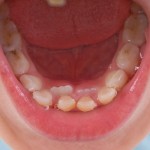
Despite the improvements in oral health the management of dental caries still presents challenges particularly in children. While some guidelines still recommend complete removal of caries there is growing interest in more conservative approaches. The aim of this study was to compare children’s behaviour and pain perception when approximal dentinal caries lesions in primary molars (in children aged 3–8 years old) were managed with three treatment strategies; conventional restorations (CR), the hall technique (HT), and non-restorative caries treatment (NRCT).
The study was conducted in secondary care with treatment provided by seven paediatric specialists and five post-graduate paediatric students. Children aged 3–8 years old with at least one primary molar tooth with caries into dentine involving two dental surfaces were randomised to either; Conventional restoration (CR) with local anaesthesia, Hall Technique (HT) or Non-restorative caries treatment (NRCT) with no local anaesthetic. Only one tooth per child was included and parents were present during treatment. Following treatment the childrens’ parents’, and dentists’ perceptions and opinions of the treatment were assessed; behaviour using the Frankl Behaviour Rating Scale; pain using Visual Analogue Scale of Faces (VASOF); treatment perceptions and opinions using a 5 point likert scale.
- 169 Children (96 boys and 73 girls) were randomised
- 52 receive HT; 52 NRCT and 65 CRs.
- 35% of children having CRs were rated by dentists as having ‘definitely negative’ or ‘negative’ behaviour, compared with 21% in the NRCT group and 13% in the HT group [P = 0.047, confidence interval (CI) 0.041 to 0.052]
- Child behaviour was not affected by the dentists’ level of experience (specialists vs. post-graduate students)
- Pain intensity was rated ‘very low’ or ‘low’ in 88% NRCT, 81% HT, and 72% CR (P = 0.11, CI = 0.10 to 0.12).
- NRCT and HT were ‘very easy’ or ‘easy’ to perform for >77% of dentists, com- pared to 50% in CR group (P < 0.000).
- None of the parental responses (treatment satisfaction, children’s behaviour/comfort) showed statistically significant differences between the groups
The authors concluded
Dentists reported more negative behaviour in CR group. For all techniques, children’s pain perception and dentist/parent acceptability were similar.
Links
Santamaria RM, Innes NP, Machiulskiene V, Evans DJ, Alkilzy M, Splieth CH. Acceptability of different caries management methods for primary molars in a RCT. Int J Paediatr Dent. 2014 Mar 7. doi: 10.1111/ipd.12097. [Epub ahead of print] PubMed PMID: 24602167.
Hall Technique Manual – University of Dundee
Ricketts D, Lamont T, Innes NPT, Kidd E, Clarkson JE. Operative caries management in adults and children. Cochrane Database of Systematic Reviews 2013, Issue 3. Art. No.: CD003808. DOI: 10.1002/14651858.CD003808.pub3.
